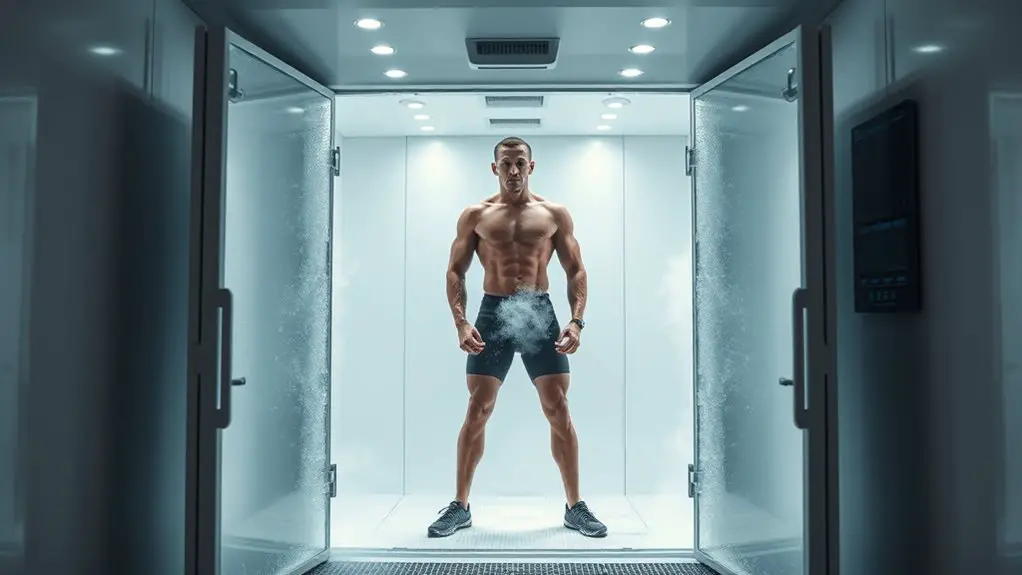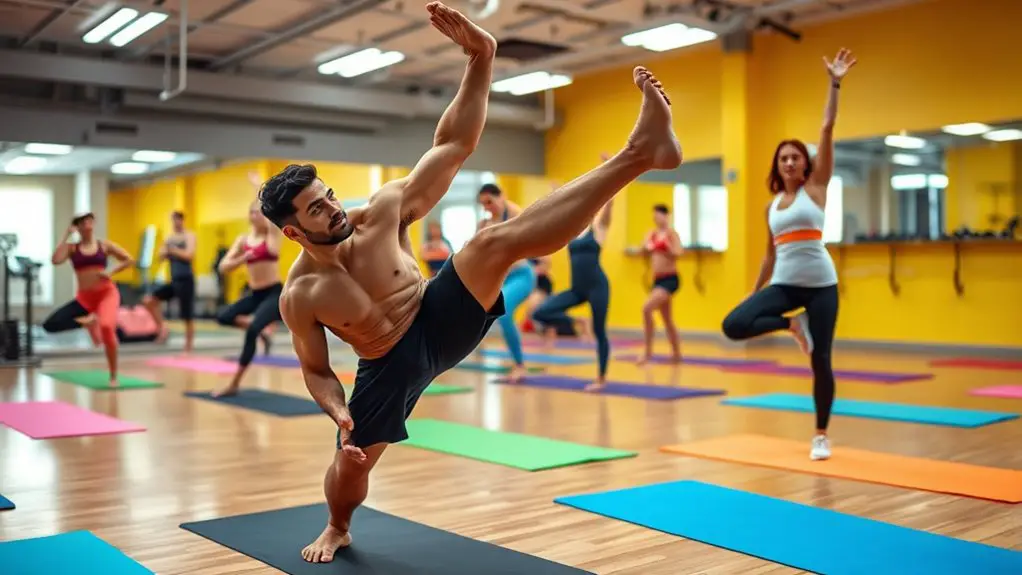To recover from chronic sports injuries, focus on proper diagnosis and tailored treatment. Engage in rehabilitation with strength training and manual therapy to regain mobility. Make sure your nutrition includes protein and omega-3 fatty acids while staying hydrated. Don't underestimate the power of mental health—develop resilience and lean on your support network. Incorporate mindfulness techniques and celebrate your progress. By following these strategies, you can enhance your recovery journey and discover even more effective ways to heal.
Understanding Chronic Sports Injuries
When you think about sports injuries, you might picture the sudden impact of a fall or a collision, but chronic sports injuries often develop gradually and can be just as debilitating. These injuries, like tendonitis or stress fractures, sneak up on you, creeping into your routine and affecting your performance. You may not even realize you're injured until the pain becomes impossible to ignore.
Understanding the nature of chronic injuries is essential for your freedom in sports. They often stem from repetitive motions or overuse, leading to inflammation and discomfort over time. Ignoring these signals can result in long-term damage, restricting your ability to participate in the activities you love. Proper warm-ups and stretching are crucial for prevention, as they can help mitigate the risks associated with chronic injuries.
Importance of Proper Diagnosis
Getting a proper diagnosis is essential for your recovery from chronic sports injuries. An accurate injury assessment helps identify the root cause, allowing for tailored treatment plans that suit your specific needs. Without this foundation, you might end up prolonging your pain and complicating your recovery. Understanding ankle sprains and their types can also inform your rehabilitation process.
Accurate Injury Assessment
Accurate injury assessment is essential for effective recovery from chronic sports injuries. You can't just ignore the pain or hope it goes away on its own. Taking the time to get a proper diagnosis helps you understand the root cause of your issue, allowing you to take control of your healing journey. When you know exactly what you're dealing with, you can make informed decisions about your next steps. Whether it's seeking a specialist or understanding which activities to avoid, clarity empowers you. Don't settle for guesswork; a precise assessment can mean the difference between a quick recovery and prolonged setbacks. Trust in the process, and prioritize getting the right evaluation to reclaim your freedom in sports and life.
Tailored Treatment Plans
While a proper diagnosis lays the groundwork for recovery, it's the tailored treatment plans that truly make a difference in healing from chronic sports injuries. You deserve a plan designed specifically for your needs, considering your unique body mechanics and lifestyle. Generic solutions just won't cut it when you're aiming for full recovery and a return to your favorite activities.
Work closely with your healthcare team to create a strategy that includes targeted exercises, nutrition, and possibly alternative therapies. This personalized approach helps address the root causes of your injury, promoting faster healing. By committing to a tailored plan, you're investing in your freedom to move, play, and enjoy life again without the shadow of chronic pain lingering over you.
Effective Treatment Options
When you're dealing with chronic sports injuries, finding effective treatment options can feel overwhelming. However, you have choices that can help you regain your freedom and get back into the game. Here are some options to take into account:
Navigating chronic sports injuries can be daunting, but you have the power to choose effective treatment options and reclaim your game.
- Active Release Techniques (ART): This hands-on therapy can target muscle tightness and improve mobility.
- Cryotherapy: Using cold therapy can reduce inflammation and speed up recovery.
- Acupuncture: This ancient practice can help relieve pain and promote healing through energy flow.
- Nutritional Support: Proper nutrition can enhance your body's healing process and strengthen your muscles. Additionally, ensuring proper hydration can further support the recovery process and reduce muscle soreness.
Each of these options offers a unique approach to tackling your injury. It's important to consult with a healthcare professional to create a plan that works for you. Embrace the journey to recovery, and take charge of your healing process!
Rehabilitation and Physical Therapy
Rehabilitation and physical therapy are essential steps in your recovery journey, especially after dealing with chronic sports injuries. They help you regain strength, flexibility, and mobility, allowing you to return to the activities you love. A personalized therapy plan can target your specific needs and motivate you to push through challenges. Incorporating rest days into your recovery plan is crucial for maximizing your healing process and preventing further injuries.
Here's a quick overview of key rehabilitation components:
| Component | Purpose | Frequency |
|---|---|---|
| Strength Training | Build muscle and stability | 3-4 times a week |
| Flexibility Work | Increase range of motion | Daily |
| Balance Exercises | Prevent future injuries | 2-3 times a week |
| Manual Therapy | Relieve pain and tension | As needed |
| Education | Empower self-management | Ongoing |
Embrace this time for healing and let your body guide you back to freedom in movement. With dedication, you can overcome these obstacles and reclaim your active lifestyle.
Nutrition and Hydration for Recovery
Healing from chronic sports injuries goes beyond physical therapy; nutrition and hydration play an essential role in your recovery. You've got to fuel your body with the right nutrients and stay hydrated to promote healing. Here are some key elements to focus on:
Nutrition and hydration are crucial for recovering from chronic sports injuries; the right nutrients fuel your healing process.
- Protein: Helps repair damaged tissues and build muscle.
- Omega-3 fatty acids: Reduce inflammation and support joint health.
- Vitamins and minerals: Essential for overall recovery; think vitamin C and zinc.
- Hydration: Keeps your joints lubricated and supports nutrient transportation. Adequate protein intake reduces soreness and accelerates recovery time, making it a vital component in your healing journey.
Incorporating Cross-Training
Incorporating cross-training into your recovery routine can greatly enhance your rehabilitation from chronic sports injuries. By mixing different types of workouts, you can strengthen various muscle groups without overloading the injured area. This not only keeps your body engaged but also prevents boredom, allowing you to maintain your passion for fitness.
Consider activities like swimming, cycling, or yoga, which offer low-impact options that promote mobility and flexibility. These alternatives can help you stay active while giving your injury time to heal. Plus, cross-training can improve your overall athletic performance, making you feel more balanced and powerful when you return to your primary sport. Engaging in cross-training can also lead to enhanced cardiovascular endurance, which is crucial for maintaining fitness levels during recovery.
Don't forget to listen to your body; if something doesn't feel right, adjust accordingly. Remember, the goal is to regain strength and mobility while enjoying the freedom that comes with exploring new activities. Embrace the journey, and you'll emerge stronger than ever.
Mental Health and Emotional Support
When recovering from chronic sports injuries, mental resilience is just as essential as physical healing. You might find that seeking professional counseling and building a supportive network can make a big difference in your journey. Remember, your emotional well-being plays an important role in the recovery process. Embracing a growth mindset can transform your perspective on setbacks and help you navigate the challenges of recovery more effectively.
Importance of Mental Resilience
Mental resilience plays an essential role in the recovery process from chronic sports injuries. When you face setbacks, your mental strength can be the difference between giving up or pushing through. Cultivating this resilience empowers you to embrace challenges and maintain a positive outlook. Here are some key aspects to reflect upon:
- Stay adaptable: Embrace change and adjust your goals as needed.
- Practice mindfulness: Engage in techniques like meditation to center your thoughts.
- Build a support network: Surround yourself with friends and family who uplift you.
- Celebrate small victories: Acknowledge progress, no matter how minor, to boost motivation.
Seeking Professional Counseling
While you may feel strong enough to tackle your recovery on your own, seeking professional counseling can provide essential mental health and emotional support. It's common to experience frustration and emotional turmoil when dealing with chronic sports injuries. A counselor can help you navigate these feelings, allowing you to reclaim your mental freedom.
| Benefits of Counseling | Description |
|---|---|
| Emotional Release | Helps process pain and uncertainties. |
| Goal Setting | Aids in establishing realistic recovery goals. |
| Coping Strategies | Teaches techniques to manage anxiety and stress. |
| Self-Discovery | Encourages exploration of personal resilience. |
| Accountability | Provides support to stay committed to healing. |
Investing in your mental health can greatly enhance your overall recovery journey.
Building a Support Network
Recovering from chronic sports injuries isn't just about physical healing; it's also about having the right people around you for support. Building a solid support network can make all the difference in your journey to recovery. Surround yourself with individuals who uplift and encourage you. Consider these tips:
- Connect with fellow athletes who understand your struggles and can share their experiences.
- Lean on friends and family for emotional support, reminding you that you're not alone.
- Join local or online support groups to share stories and gain insights from others facing similar challenges.
- Engage with mental health professionals who can guide you through the emotional ups and downs of recovery.
Having a supportive network empowers you to embrace freedom and healing.
Frequently Asked Questions
How Long Does Recovery Typically Take for Chronic Sports Injuries?
Recovery from chronic sports injuries can vary widely, often taking weeks to months. It depends on factors like injury type, treatment, and your body's healing ability. Patience and consistent care are key to getting back on track.
Can I Still Exercise While Recovering From a Chronic Injury?
You can still exercise while recovering, but you'll need to adjust your routine. Focus on low-impact activities, listen to your body, and prioritize healing. Freedom lies in finding new ways to stay active and enjoy movement.
What Are Common Misconceptions About Chronic Sports Injuries?
You might think chronic sports injuries only affect elite athletes, but that's not true. Many believe rest alone heals them, ignoring rehabilitation's importance. Misunderstandings can hinder recovery and prolong pain, limiting your freedom to move.
When Should I Seek a Second Opinion for My Injury?
You should seek a second opinion if your injury's not improving, you're unsure about your treatment, or you feel uncomfortable with your doctor's advice. Trust your instincts; your health and recovery are what matter most.
Are There Specific Exercises to Avoid During Recovery?
During recovery, you should avoid high-impact exercises and anything that causes pain. Focus on low-impact activities instead. Listen to your body, and don't push through discomfort; it's crucial to allow proper healing.




